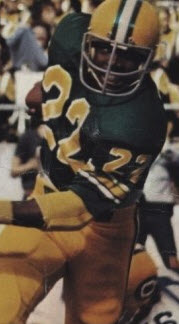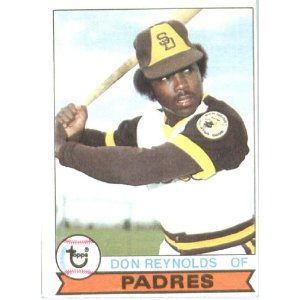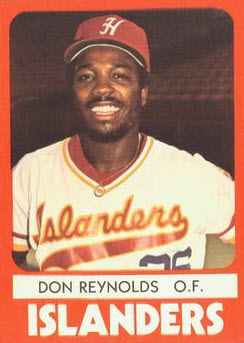This is part two of a profile of two-sport Oregon great Don Reynolds, written by John Schroeder. If you missed part one, catch up here.
It’s an interesting question, if you know that back story: How does a Corvallis resident – one who was a high school teammate of current Oregon State coach Mike Riley, son of then-Oregon State assistant Bud Riley, and talented enough to play for the Beavers – end up as an Oregon Duck? [See footnote 1, below].
In part two of this profile on former star Don Reynolds, we find out about that and where he went after his days in Eugene.

Don Reynolds
Don Reynolds was recruited by Oregon State solely to play football. At the same time he was recruited by the Ducks only to play baseball. Reynolds says he would have likely stayed in Corvallis if he was also allowed to play baseball, but that was never offered as an option. Other more pernicious reasons eventually swayed him toward Eugene.
By the end of the 1960’s, the Civil Rights Era and John Carlos’ and Tommie Smith’s “black power” salute at the Mexico City Olympics were prominent in the minds of black university athletes. Due to mounting racial unease at Oregon State, Reynolds believes Beavers head coach Dee Andros wanted to limit the amount of black athletes at the school, and subsequently the football team.
During the 1969 season things took a turn for the worst, when linebacker Fred Milton, in violation of team rules, refused to shave his beard. Andros subsequently kicked him off the team, and many suspected racial animus in the act. (Keep in mind; this discipline occurred in December, after the season).
As a result of this uncomfortable campus environment, black students started to leave the OSU program en masse and recruiting black athletes to Corvallis became increasingly difficult, leading the Oregon State teams of the 1970s to have a hard time competing as a direct result of this perception [see footnote 2, below]. In retrospect, Oregon State’s fall in the early ’70s was foreseeable and tied to a much larger sociological current – to be fair, bigots are obviously not confined solely to Corvallis.
Defensive coach Bud Riley admitted that these issues had a detrimental effect to the team, saying “it slowed the program down.” In the end, it made the social situation and the community of Corvallis much more divisive than it needed to be. Reynolds said, “One of the hardest things I ever had to do was tell Bud Riley that I was not coming to Oregon State, but instead I was going to Eugene to be a Duck.” To Reynolds, there were no such overt racial barriers on the Oregon campus and he made his way south to Eugene.
Reynolds indicated, on a less serious note, that the Full House T-Formation offense that Oregon State ran at the time was not suited to his open and free-wheeling style.
In part one, we covered his successful Duck football career. Reynolds was just as dynamic a baseball player as well. He was a three-year starter, and all-conference performer, while patrolling centerfield for Oregon. He finished with seven career baseball records with the program, including hits, RBI’s and stolen bases.

Don Reynolds played two years for the San Diego Padres
Although Reynolds’ two-sport status hurt him in finding work in football, he found no such obstacles in baseball. Drafted by the San Diego Padres in 1975, Reynolds moved fast through the system, tearing up single-A ball at Walla Walla, WA, with 15 home runs, 61 RBI’s, and a batting average, on base percentage and slugging percentage line of .319, .452, and .563 that summer.
He continued his torrid hitting in 1976 at Amarillo in the Texas League, hitting 19 home runs with 85 RBI’s a .436 OBP and a .532 slugging percentage. The next year, Reynolds hit .368 at triple-A Hawaii and subsequently made the Padres out of spring training in 1978 with a roster that included future Hall of Famer Dave Winfield sharing the outfield with him.
Reynolds’ first major league base hit was in Atlanta against the Braves on April 11th, 1978 off of Phil Niekro in the top of the 8th inning. Of course, it was a knuckleball from Niekro, as Reynolds confirmed in our interview. It was a solid single scoring Jerry Turner and Gene Richards with the go-ahead runs leading to a 3-2 Padres win.
He finished 1978 and continued through 1979 as a role player for the Padres; picking up spot starts here and there, and shuttling between San Diego and Hawaii. As with any young player, he may have been better served with either another year in the minors, or with a full time role at the major leagues. Sitting on the bench does not serve the young player well, and in Reynolds’ case it affected his long-term prospects.
Reduced to playing in B games during spring training in 1980, he could see the writing on the wall. It seems that, according to Reynolds, Padres management wanted his “performance to prove them right.” He was sent back down to triple-A Hawaii by the Padres in 1980 before his release, where he was later picked up by the Seattle Mariners.
He played at triple-A Spokane in 1981, but by 1982, after a short stint in spring training in the Mariners camp, Reynolds was out of professional baseball. Reynolds is still a little bitter regarding the end of his professional baseball career; in stark contrast to his warm feelings at the end of his collegiate career. He felt he could still play but eventually, as it is in many walks of life, someone in a position of authority thinks otherwise.

Don Reynolds with the Islanders
That same year, Reynolds experienced another disappointment, when he watched the University of Oregon reduce baseball from varsity status to merely a club sport. Reynolds says “having a baseball program has a residual effect on all of the Oregon athletic programs,” adding, “if Oregon did not have a baseball program, I would never have considered enrolling.” According to him, other two-sport athletes at Oregon felt the same way; that a viable athletic department with a full complement of programs draws outstanding student athletes to the university [see footnote 3, below].
How does Don Reynolds feel he’s remembered? He acknowledges that he is largely unknown, except to avid long time University of Oregon sports aficionados, and understands that “fans can be fickle” and not always in tune to the context of the times and the elements out of an athlete’s control. He willingly acknowledges that what he did at Oregon is rare:
“Not many people could have done what I did. I maybe could have done more but I am proud of what I did.” His resume is impressive: He played baseball and football at a very high level, graduated from Oregon with a degree in Psychology and was part of the second class inducted into the University of Oregon Sports Hall of Fame.
In the end, he did what he came to Eugene to do; not just play, but dominate.
These are articles where the writer left and for some reason did not want his/her name on it any longer or went sideways of our rules–so we assigned it to “staff.” We are grateful to all the writers who contributed to the site through these articles.
